|
 The
Olmecs:
(The 'Rubber People') The
Olmecs:
(The 'Rubber People')
The Olmecs are
one of the most fascinating civilisations in the Pre-Columbian
Americas. They are easily recognised by their creative,
enigmatic, and soulful artwork; They were the first to introduce
ball-courts and they are candidates for the first writing and
the initiation of the long-count. All of these features are seen
in later Meso-American cultures justifying the Olmecs status as
one of the
forefathers of American civilisation.
(Quick-links)
Chronology: The Olmecs
existed as a fully-fledged civilisation in Mesoamerica from
approx' 1,600 BC -
400 BC, with evidence of 'Pre-Olmec' activity in the region
since 2,500 BC, but it wasn't until around 1,500 BC that they became
the dominant power in Mesoamerica.
The first Olmec centre,
San Lorenzo, was
more or less
abandoned around 900 BC at about the same time that La Venta rose to prominence.
A wholesale destruction of many San Lorenzo monuments
also occurred
c. 950 BC, which may indicate an internal
uprising or, less likely, an invasion.
The latest thinking, however, is that environmental
changes may have been responsible for this shift in
Olmec centres, with certain important rivers changing
course.
Following the decline of San Lorenzo,
La Venta became the most prominent Olmec centre, lasting
from 900 BC until its abandonment at around 400 BC.
La Venta sustained the Olmec cultural traditions, but
with spectacular displays of power and wealth. The
Great Pyramid was the largest Mesoamerican structure of
its time.
Buried deep within La Venta, lay opulent, labour-intensive
"offerings" � 1000 tons of smooth
serpentine blocks, large mosaic pavements, and at
least 48 separate
deposits of polished jade
celts, pottery, figurines, and
hematite mirrors.
(More
about La Venta)

(Image Credits:http://www.latinamericanstudies.org)
|
The
Multi-cultural Olmecs: |
A Selection of
Facial Types in Olmec Art.

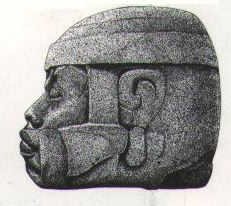
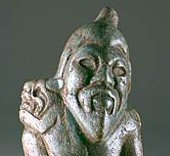
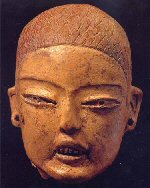
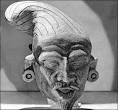

One of the most
intriguing aspects of the Olmecs is their
lifelike portrayal of different racial types
in their art. From the earliest discoveries
of the huge carved-stone 'African' heads, to
the extraordinary similarity to the Chinese
Shang culture in art and text, the Olmecs
appear to have been influenced by several
racial types, making them possibly one of the
earliest true multi-cultural societies in
the Americas. There has been much debate
over this issue, although the
evidence is in favour of the probability of
contact with old-world cultures from both
the Pacific and the Atlantic, it is yet to
be officially accepted by academia. It is
perhaps no coincidence that the Gulf of
Mexico is the narrowest continental separation between
the two oceans.
The following
'circumstantial' examples
illustrate the
similarities
between the two
cultures, and
why the theory
has gained
weight.
Evidence to
Support an Oriental
Connection:
'According to
several authors, including Mike Xu, professor of
Chinese studies at the University of Central
Oklahoma, the Olmecs are descendants of ancient
Chinese. The Olmec culture began
around 1500 BC, at around the same time as
China�s Shang dynasty (c. 1,766 to 1,122 B.C.).
According to ancient chronicles of that era,
when the Zhou were invading and plundering the
Shang, records state that the son of the emperor
brought 25,000 adepts toward the �eastern
ocean.�
'Ancient Olmec artefacts
give the theory further
substance. The written
language found on the
Olmecs� jars, pottery, and
statues reveals what could
be the actual influence of
Chinese culture. Professor Xu points out that various
words found on these
decorative objects match
exactly with those used in
Shang China: Sun, Mountain,
Artist, Water, Rain,
Sacrifice, Health, Plants,
Wealth, and Earth. In fact,
the majority of the 146
characters used by the
Olmecs are exactly the same
as primitive Chinese
writing. When Xu showed the
Olmec artefacts to
university students involved
in analyzing primitive
Chinese culture, they
actually believed it was
ancient Chinese script'.
(3)
Back in the 1960s,
the renowned Smithsonian archaeologist Betty
Meggers argued that similarities between the
pottery of the contemporaneous Valdivia culture
in Ecuador and Japan�s Jomon culture indicated
that Japanese fishermen had �discovered� America
about 5,000 years ago. Whilst the theory was
lambasted by critics, the largest ever genetic
study of native South Americans was conducted
recently, and the results identified a
sub-population in Ecuador with a clear link to
eastern Asia. The study, published in PLOS
Genetics, concluded that Asian genes had
been introduced into South America sometime
after 6,000 years ago � the same time the Jomon
culture was flourishing in Japan.
(9)
(More
about Prehistoric Japan)
Taotie's
(Gluttonous Ogre
Masks).
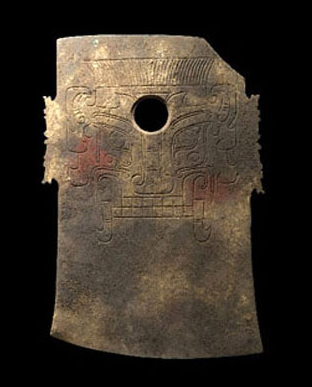 
Left, Jade carving from the Shang Dynasty. China c.
1600 - 1100 BC.
(1),
Right, Olmec Jaguar-God masks.
A Reverence for Jade.
Both Chinese and Olmec cultures are known for
their reverence for Jade. In China, Jade has been mined since 6,000
BC
(4) Jade is considered to be
comparable to gold or diamonds, and was used for the finest
carvings, objects d'art, and royal grave furnishings. In
Mesoamerica, Jade was equally valued and was esteemed by both the
Olmec and Mayan elite.
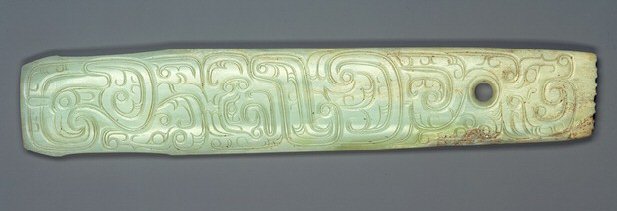
Jade 'Celt' from the Zhou Dynasty (c. 1046 - 771
BC)

Olmec Jade 'Celt' from Mexico. (c. 1100 - 600
BC)
Both the Olmecs and
the Chinese had a strong tradition of making jade face masks. They
have been found in various settings but are generally considered to
be 'funerary' in nature.

This exquisite
Jade mask was recently discovered (2012) under the 'Pyramid of the
Sun' in Teotihuacan, Mexico.
(Link to Article:
http://www.presstv)

This 'wrestler' from
La Venta has clear Asian
characteristics: The beard is not found in the Amerindian genotype.
Evidence to Support an African Connection:
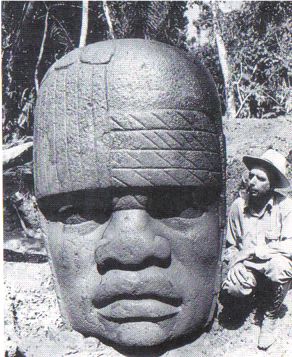 The
huge stone heads in the Mexican jungles were first officially
described in 1938 by a Dr. Stirling, who said of them that they were: The
huge stone heads in the Mexican jungles were first officially
described in 1938 by a Dr. Stirling, who said of them that they were:
'...unique amongst aboriginal
American sculptures, it is remarkable for its realistic treatment.
The features are bold and it is amazingly negroid in character'.
They have since been termed 'negroid' in appearance by various
authorities since, but this is in itself, is considered insufficient
proof of an African contact. The early suggestions of a Pre-Columbian contact
with Africans by Van Sertima and others, have since been confirmed by
associated studies in Craniology, Genetics and Linguistics.
Craniology: In 1972,
craniologist Andrzej Wiercinski reported that 13.5% of the 76
fragmentary crania from Tlatilco, a site associated with the Olmec
civilization, showed "a
clear prevalence of the total Negroid pattern" (Jordan 1992).
Wiercinski measured the skulls for 48 morphological traits, but
focused on the traits he considered best for discriminating between
the "three great races of man" (Van Rossum 2004). The remains were
dated to the Pre-Classic Period (1,500 BCE-300 CE),
well before the arrival of Columbus.
(5)
African Skeletal
Remains In Mexico:
http://bafsudralam.blogspot.com/2009/10/dr.html
The Mali Empire:
Perhaps more than coincidentally, North African sources
describe what some consider to be visits to the New
World by a Mali fleet in 1,311.
(15) According to these sources,
400 ships from the Mali Empire discovered a land across
the ocean to the West after being swept off course by
ocean currents. Only one ship returned, and the captain
reported the discovery of a western current to Prince
Abubakari II; the off-course Mali fleet of 400 ships is
said to have conducted both trade and warfare with the
peoples of the western lands. It is claimed that
Abubakari II abdicated his throne and set off to explore
these western lands. In 1324, the Mali king Mansa Musa
is said to have told the Arabic historian, Al-Umari that
"his predecessors had launched two expeditions from West
Africa to discover the limits of the Atlantic Ocean."
Monument 'Q' From
Tres Zapotes.


(Right): The rear of Monument Q
showing Ethiopian style braided hair.
Genetics:
According to the findings of a Dr. de Garay, the director of the
Genetic Program of the National Commission of Nuclear Energy in
Mexico. Dr. de Garay identified the malaria resistant mutant gene,
that produces sickle cells, in the blood of the Lacandones Indians,
one of the oldest and most secluded tribes in Mexico. This tribe, of
Mayan stock, who inhabit the forests of the upper waters of the
Usumacinta river have not been known to mix with outsiders in
post-Columbian times yet they possess a gene that is �usually found
only in the blood of black people.� (19)
The following
comment by F. Hayes Ph.D. is also very telling. In 1854, at the
National Emigration Convention of Coloured People, held in
Pittsburgh, Pennsylvania, a statement was issued to the African
inhabitants of the United States of America regarding the necessity
for leaving the USA as the only alternative left for them. Within
that statement was the following observation:
'And among
the earliest and most numerous class, who have found their way
to the new world, were those of the African race. And it has
been ascertained to our minds beyond a doubt, that when the
continent was discovered, there were found in the West Indies
and Central America, tribes of the black race, fine looking
people, having the usual characteristics of colour and hair,
identifying them as being originally of the African race' .
(20)
Article: GambiaEcho
(2011). 'Africans in Pre Columbian America'. ( Quick-link)
(The
Carved Olmec Stone-Heads)
(Old-world
/ New-world Contact)
There have now been
several discoveries of 'glyphs' from authenticated Olmec sites. This
evidence leaves no doubt that the Olmecs were the first Mesoamerican
people to develop a writing system. There are claims that the text
originates both from the Chinese Shang dynasty, and from the African
Manding-she tribe, neither have yet to be substantiated. What we do
know is that the Olmecs were using glyphs to denote dates or names
on small pottery, monuments since around 1,000 BC and the recent
discovery of the Cascajal Block (below) suggests that the same text
was also used to record important information.

The ancient
serpentine tablet (The Cascajal Block) is dated to around 900 B.C.
It is the oldest accepted example of writing in the New World,
scientists say. The tablet contains 62 symbols in 28 shapes arranged
in horizontal patterns (6)
(Photo Credits:
National Geographic)
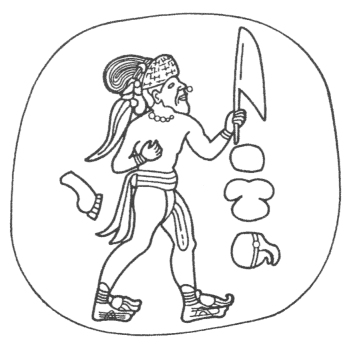 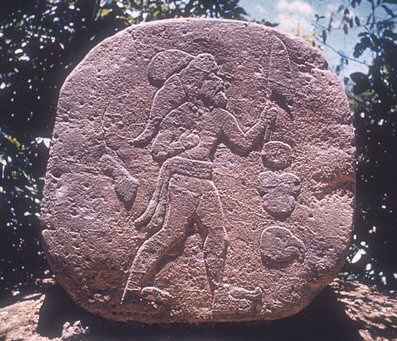
'Monument 13' at
La Venta. (Note also the Beard)
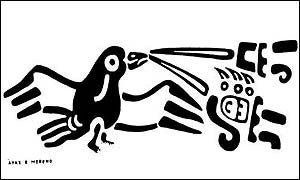
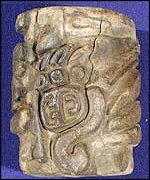
This cylinder
seal was found in an Olmec context. It is suggested to spell the
name of a king or a date. (3, Ajaw)
Olmecs and the
Long-Count.
In 1939, archaeologist
Matthew Stirling discovered at Tres Zapotes the
bottom half of Stela C. This stela was carved from basalt, with one side showing
an Olmec-style engraving that has been variously
characterized as an abstract
jaguar or a ruler on a throne.
On other side was the oldest
Mesoamerican Long Count calendar date yet unearthed.
This date, 7.16.6.16.18, correlates in our present-day
calendar to September 3, 32 BCE, although there was some
controversy over the missing baktun, the first
digit, which Marion Stirling, Matthew's wife, had
contended was a '7'. Her judgment was validated in 1969
when the top half of the stela was found.

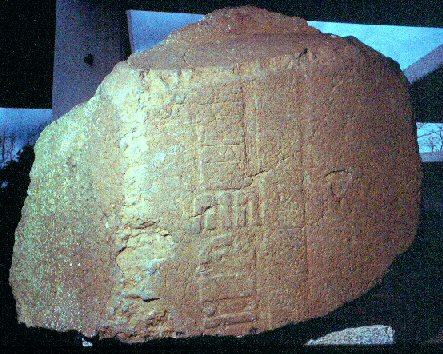
Stela C from the Olmec Site of Tres
Zapotes which dates to 32 BC. Bottom Half (Left), Top
Half (Right)
In a paper by Malmstr�m, 1992,
the theory was put forward that the meaning of the inscription
on Stela C may well be found in a
monumental work of European science first published in 1877.
Known as Canon der Finsternisse,
or "Table of Eclipses," the volume is the work of Theodor von
Oppolzer, an Austrian count, and a team of his assistants, and
constitutes a catalogue of over 8,000 solar and 5,200 lunar eclipses
ranging in date from 1208 B.C. to A.D. 2,161. Although his 376
pages of calculations and 160 maps charting the central paths of
the solar eclipses were all carried out by hand, their accuracy
has only recently been reconfirmed by modern researchers using
computers (Meeus and Mucke, 1979).
Listed as event no. 2803 in Oppolzer's list of
solar eclipses is one whose path of centrality passed right over
the Olmec ceremonial centre of Tres Zapotes at dawn on the
morning of August 31, 32 B.C. Although today, we understand the
science behind eclipses, this particular celestial event
may well have had a special significance for the Olmecs, for the sun rose out of the Gulf of
Mexico totally black except for a ring of light around its outer
edges. Oppolzer described it as an annular, or ring-like,
eclipse, and subsequent calculations at the U.S. Naval
Observatory have revealed that the disk of the sun was 93
percent obscured, so a "day
without a sunrise" is not likely to have been recorded by the
Olmecs.
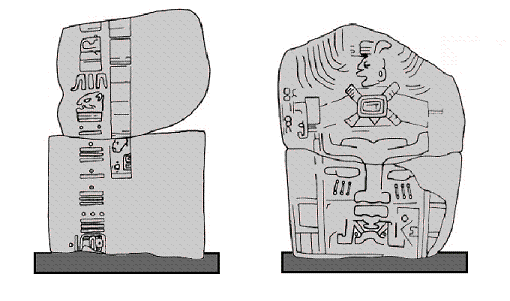
It is
worth noting that in association with Stela C are several
glyphs associated with epi-olmec script.
(The
Origin of Writing)
Gallery of
Images: The Olmecs.

Olmec Pot from
Jalapa Museum (Now vanished) Make your own mind up...!
Article:
'Depictions of Pre-Columbian
Elephants in the America'.
(Quick-link)
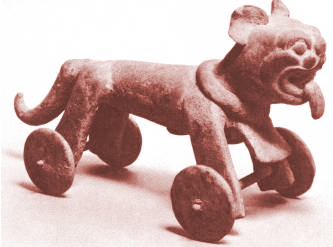
One of several
Olmec wheeled toys, proving the presence of the wheel in
Pre-Columbian America.
(Tuxteco
Regional Museum, Santiago Tuxtla, Veracruz)
(Tres
Zapotes) (La Venta) (San
Lorenzo) (Monte Alban)
(Cuicuilco)
(Mexico
Homepage)
(Pre-Columbian
America)
|













 The
huge stone heads in the Mexican jungles were first officially
described in 1938 by a Dr. Stirling, who said of them that they were:
The
huge stone heads in the Mexican jungles were first officially
described in 1938 by a Dr. Stirling, who said of them that they were:









